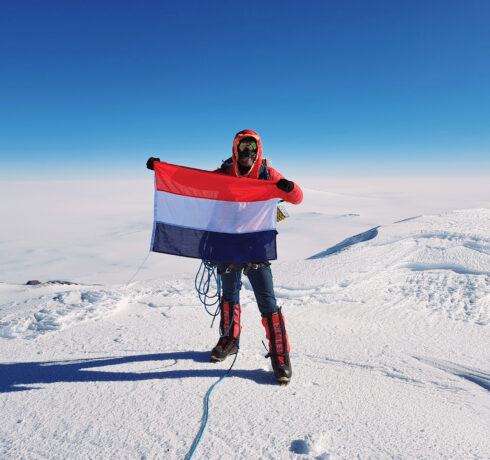Damen Naval Senior ILS Engineer Ricardo Kaljouw has spent his free time in the last ten years working towards the goal of completing the Volcanic Seven Summits challenge. On 24 January – at the top of Mount Sidley in Antarctica – he succeeded (pictured above). This places him in a select group of adventuring mountaineers: he is the first person from the Benelux, and only the 50th person in the world to have climbed the seven highest volcanoes on each of the seven continents. Even though the seventh climb was actually the smallest of the seven peaks at ‘only’ 4,285 metres high, it was most certainly Ricardo’s most challenging expedition to date.
In an ideal world, an actual ascent of Mount Sidley takes about four or five days. This is a three-stage journey from base camp to ‘high camp’ to the summit, and back again. However, due to a variety of challenges arising along the way, Ricardo and his fellow climbers spent a total of 14 days and multiple attempts before achieving success.
First things first: how do you actually get to the Antarctic continent? “I flew from Punta Arenas, Chile, to Union Glacier. This is a camp where all kinds of expeditions leave from. Some people are skiing to the South Pole, some are going to climb the highest mountain of Antarctica, Mount Vinson: all kinds of adventurers gather there”, begins 38-year old Ricardo. In the Antarctic, timing is key: the expedition season consists of just December and January.
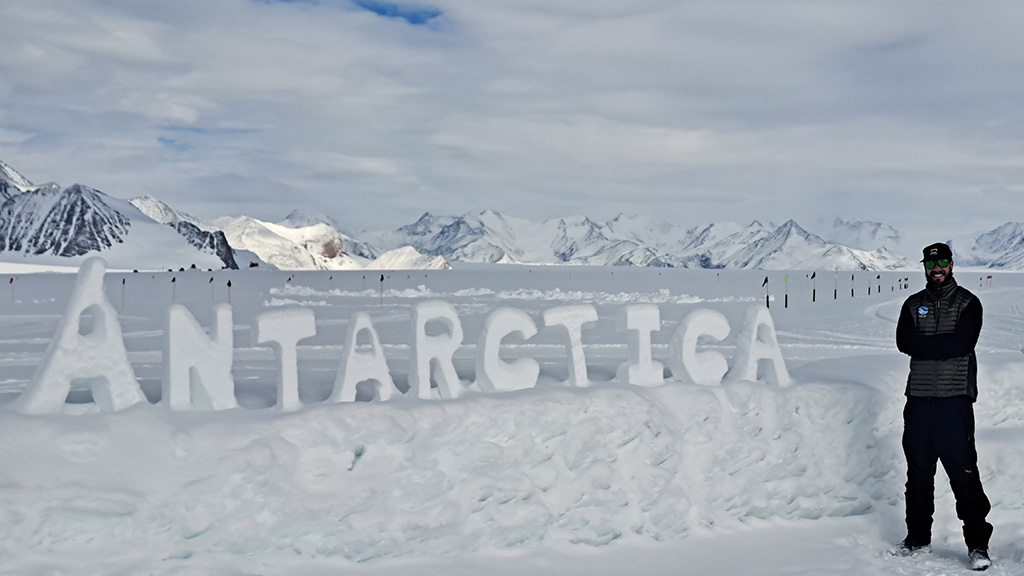 Ricardo Kaljouw’s final step in the Volcanic Seven Summits challenge was to Mount Sidley, Antarctica.
Ricardo Kaljouw’s final step in the Volcanic Seven Summits challenge was to Mount Sidley, Antarctica.
Once his expedition group of three people (himself, another climber, and a guide) got the green light to proceed, they flew as near as possible to the base of Mount Sidley. This three and a half hour, one thousand kilometre flight was on a DC-3 dating back to 1942. “It was like stepping into an aviation relic,” smiles Ricardo.
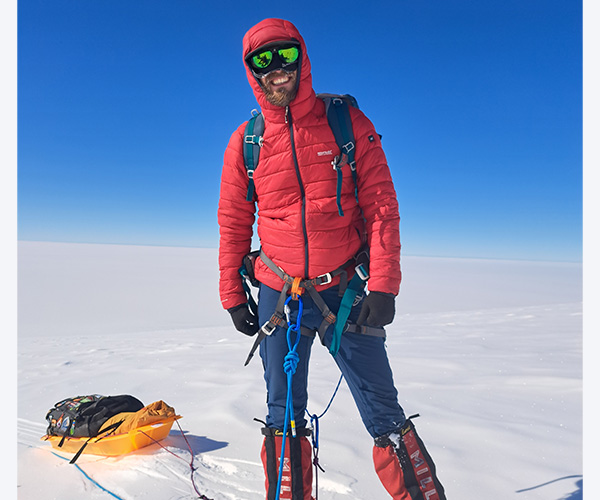 Ricardo divided his equipment between a rucksack (20kg) and a sledge (30kg).
Ricardo divided his equipment between a rucksack (20kg) and a sledge (30kg).
At this point, you have to remember that there are no airstrips on Antarctica; the pilot has to find a suitable place to land from the air. “You don’t know exactly where you’re going to land: every year it’s in a different location. So the pilot circles with the plane like a vulture, checking, checking, and then lining up on a good spot. For us, it meant that our base camp was around six kilometres away from the foot of the volcano. This doesn’t sound too far, but in an icy world with a lot of equipment, that is quite a distance.” The DC-3 stayed on site in case of emergency (a fact that will come in very handy further on in the story).
Talking of temperatures, just how cold is summer in the Antarctic? “The elements are extreme: down to minus 40 degrees Celsius”, answers Ricardo. “But when you are walking with a sledge and a backpack, you warm up pretty fast. And when it is sunny it can be quite reasonable: about minus 30. But as soon as there’s the slightest breeze, the cold cuts into your body like a knife. So you cannot have any skin exposed.”
The weather the very next day looked good enough to make the climb to the mid-way camp known as ‘high camp’. They left, fully loaded with a 20 kilo backpack and a sledge with 30 kilos of additional equipment. After spending the night at ‘high camp’, Ricardo was positive. “I thought it was going to be a very easy expedition because the next morning the weather was pretty good. Unfortunately, the guide got sick during the night. He was developing symptoms of pulmonary edema. This is quite severe – we had to take it seriously – so at that moment our priority was not the summit, it’s about getting that person out of there as quickly as possible.” Therefore, Ricardo and his fellow climber accompanied their guide down the volcano, burying their equipment at ‘high camp’ to reduce their load. A different aeroplane was called to bring in a doctor and a new guide; this left immediately, taking the first guide back to Union Glacier.
"As soon as there’s the slightest breeze, the cold cuts into your body like a knife. So you cannot have any skin exposed.” Ricardo Kaljouw
With the new guide on hand, Ricardo set out from base camp for a second time. However, during the ascent, the three-man team encountered a Polish expedition in serious trouble. “They had gotten caught in a storm near the summit and had spent about 31 hours unsheltered in minus 40 degree conditions. Some of them had frostbite that would need amputations; one even had a frozen eye. These people needed our help so we took them back to base camp. The DC-3 fired up its engines and took them to safety.”
Ricardo and his two companions were then the only people at base camp. “We were probably the most isolated people in the whole planet at that moment.” It was then when the weather took a turn for the worse, which put a stop to any kind of attempt. After six days, the clouds cleared, bringing the summit into view, and they set out on their third attempt. Unfortunately the visibility worsened to a point that “I could not see my guide in the front, and I could not see the other climber behind me”. There was only one option open: abort the attempt and descend the volcano.
After nine days at base camp, the weather improved enough for the team to make their fourth attempt. “Visibility was good”, recalls Ricardo. “But we came across a pretty big crevasse – one that we had not seen before.” This could mean only one thing: they were somewhere else on the volcano, not on the route to ‘high camp’, where their much needed equipment was stashed. Again, the only option was to descend the volcano.
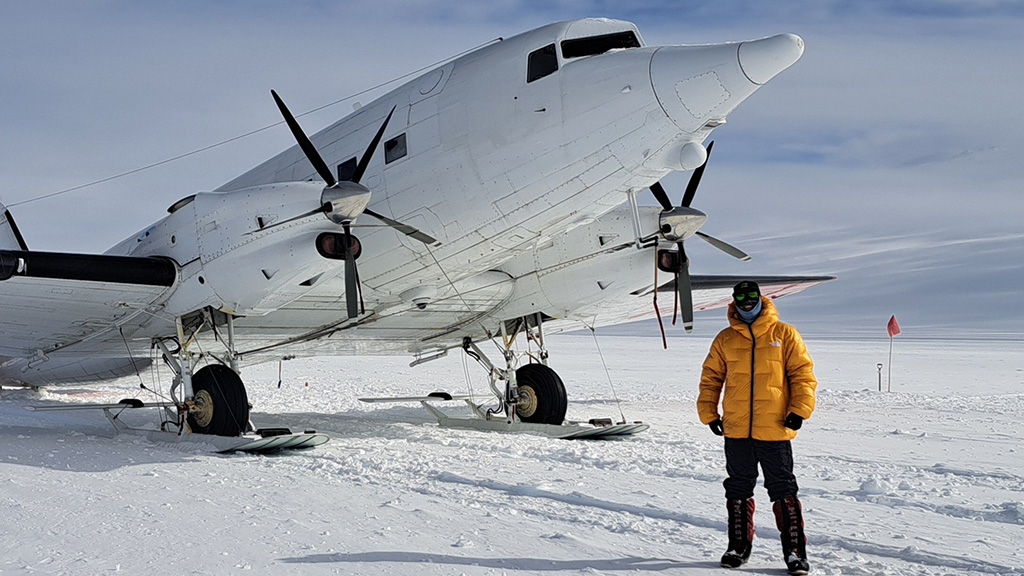 Flying on this DC-3 from 1942 was “like stepping into an aviation relic”.
Flying on this DC-3 from 1942 was “like stepping into an aviation relic”.
Then came the fifth attempt, which, because of aeroplane logistics and the approaching end of the expedition season, would also have to be the final attempt. The weather had luckily turned in their favour and they reached ‘high camp’ after leaving it twelve days earlier. “The camp looked totally different as there had been a lot of storms. So it was hard to find our buried equipment: food, fuel, clothing”, Ricardo says.
“This volcano has been climbed only by 100 people in history. Furthermore, the crevasses are constantly changing: every year it’s a different puzzle. There is no route.” Ricardo Kaljouw
After trying to catch a few hours of sleep – which was hard due to his excitement – Ricardo opened his tent and saw the best weather conditions he had seen since arriving on Antarctica. He woke his fellow climbers and within an hour, the three of them were on their way to the summit, taking only the essentials with them. “An emergency blanket and an emergency tent, for example, we didn’t want to be caught out like the Polish team.”
If you try to imagine the final ascent from ‘high camp’ to the summit, a crucial aspect is the lack of pre-defined route. Ricardo explains why: “This volcano has been climbed only by 100 people in history. Furthermore, the crevasses are constantly changing: every year it’s a different puzzle. There is no route.”
Their ascent passed a zone of ‘snow mushrooms’. Despite their rather innocent name, these natural ice formations can be lethal. Ricardo: “These are big pieces of ice created by high-velocity winds; they can be 30 to 40 metres high. If they break off and hit you…. you’re gone.”
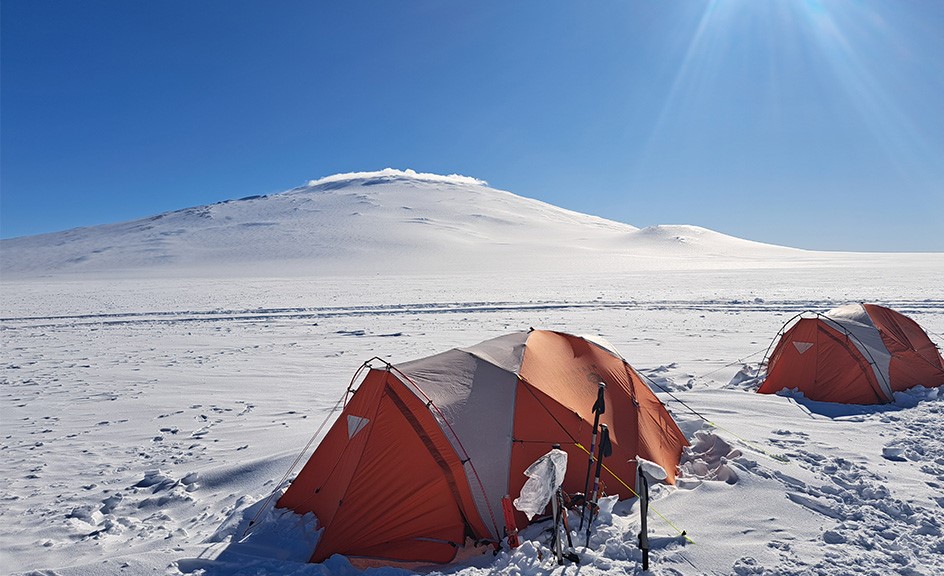 Mount Sidley base camp: six kilometres from the foot of the volcano.
Mount Sidley base camp: six kilometres from the foot of the volcano.
Nine hours after leaving ‘high camp’, they reached the summit. “The temperature was minus 42, the wind was reasonable, we stayed there for about ten minutes.” Celebrations in the world of mountaineering are generally put off until you reach the bottom. “When you are at the top, you are only halfway there: you still have to go back.”
As soon as they started their descent, the weather changed. “The wind picked up, things started to freeze: my beard, my goggles, my hat, everything was frozen against me.” After four hours, the team reached ‘high camp’ again and the day after that, they made their last journey to base camp, to the aeroplane waiting to take them back to Union Glacier. And just twelve hours later, Ricardo was back in Punta Arenas, Chile again.
Now that Ricardo is back home, how does he feel about achieving the Volcanic Seven Summits challenge? “When I started mountaineering, I never thought that I would do something like this. But I have succeeded in something that I have been working on for ten years. I have this title in my pocket and that is a great feeling. It’s a little bit of Dutch mountaineering history.”
What’s next for Ricardo? “My focus at the moment is to write the last chapter of my book, which is all about my experiences with the Volcanic Seven Summits. Once this is published, maybe this will give me more exposure for sponsorships. And in terms of my next expedition or challenge, I have to think carefully about what I am going to do because, for me, if I start something, I want to finish it.”
Ricardo Kaljouw’s Volcanic Seven Summits
2015: Kilimanjaro, Africa. 5,895m
2017: Elbrus, Europe. 5,642m
2019: Damavand, Asia. 5,610m
2022: Mount Giluwe, Oceania. 4,368m
2023: Pico de Orizaba, North America. 5,636m
2023: Ojos Del Salado, South America. 6,893m
2025: Mount Sidley, Antarctica. 4,285m
Read a previous Schelde Schakels article about Ricardo’s passion for climbing volcanos here.

